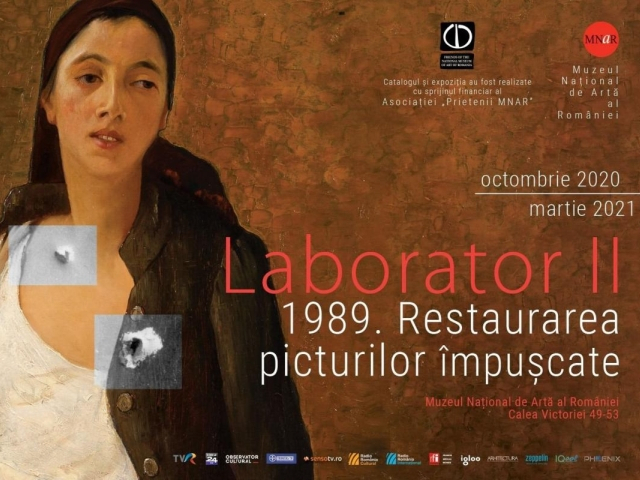The Art Destroyed by the Romanian Revolution
Major works of art were lost in the 1989 Revolution in Romania

Steliu Lambru, 11.01.2021, 14:00
The price in human lives was great in the December 1989 revolution in Romania, not just as number of people who were killed, but also in terms of wounded and crippled people. However, we could add to that price a significant part of the national cultural heritage, lost in the fires in the former Royal Palace, home to the National Art Museum, and the Central University Library. They both lie on Victoria Road, across from each other, and were both damaged by bullets and projectiles fired in the chaos that ensued after the dictator Ceausescu fled. In the fire in the Central University Library, around 400,000 books and valuable manuscripts were lost, and at the National Art Museum, dozens of major paintings, Romanian and European, fell victim to flames and bullets.
Recently, the National Art Museum inaugurated the exhibition Laboratory II 1989. Restoring paintings riddled with bullets, which aims to give back to the public some of the paintings that were damaged in 1989.
Now, curators Sorina Gheorghita and Ioan Sfrijan told us the story of an exhibition that Romania was not supposed to have. Here is Sorina Gheorghita:
“In the general mayhem at the National Art Museum, the laboratory of restoring canvas paintings was destroyed almost entirely. However, as the exhibition catalog tells you, almost immediately, in January 1990, work started being done to protect and even start restoring some of the pieces that were affected, both in the Romanian and the European galleries. In the Romanian gallery we have restored 47 pieces, and in the European one we have restored 30. We also sent some of them to be restored abroad, those in the European gallery.”
Among the paintings that have been restored, and now exhibited, are a number of paintings by major artists such as Andreescu, Grigorescu, Hentia, and Mirea. Here is Sorina Gheorghita once again:
“All the works that were damaged in 1989 were in the museums permanent exhibition. That is why they were damaged in the first place. After the museum re-opened, we changed the structure, and the damaged paintings were taken out of the permanent collection. We used this opportunity to bring out of storage paintings that were there from before 1989. Some of the most important works we have exhibited were Safta the Flower Girl and Self-Portrait by Ion Andreescu, another beautiful piece by him, The High Road. We also have works by Nicolae Grigorescu that were damaged: The Hunted Game, the Bouquet, and The Gypsy from Ghergani. We also have Lorica, one of the more special paintings by Stefan Luchian, several pieces by Sava Hentia, and one of the sketches made by George Mirea for one of his large sized paintings.”
The damage sustained by the paintings was mostly in terms of framing, others had damage to the paint itself, but some suffered major harm, to the extent that they were irrecoverable. Here is Sorina Gheorghita once more:
“Of the seriously degraded ones we had Mireas sketch, and the Landscape by Andreescu. Andreescus Self-Portrait had its paint damaged a lot. One of the major losses was a large sized self-portrait by Aman, one of the very few, which was very large, with very complex painting. There are one or two more pieces that we have in storage, very large ones, which have major losses, and which cannot be replaced, because restoration doesnt work on such large surfaces.”
The exhibition also has explanatory panels, detailing the work that had to be done by Romanian and European restorers in all these years. We asked Sorina Gheorghita if the damage was the result of gratuitous vandalism back in 1989, in addition to the fires and the shooting:
“In the end, shooting is an act of vandalism, because many of the paintings were shot intentionally, hitting the characters in the head or chest. For some of the paintings, I cannot believe that the shooting was random. It had to be intentional, as was the case with Safta the Flower Girl, which is why we made it the poster of the exhibition. Some, however, were most likely damaged at random.”
Ioan Sfrijan talked about the fire in the restoration lab, the worst affected place in the museum:
“There they shot shells, and there were incendiary gases. There is one room where we had the storage. There, a lot of Amans paintings were destroyed, because they were preparing an Aman dedicated exhibition, including the self-portrait. There was also The Man With Turkish Medals, which was also shot, but that is not in the exhibition. They were also preparing the European Art Gallery, a major exhibition of portraits, which was why many portraits were lost, no less than 39 pieces.”
47 Romanian and 30 European paintings damaged in the 1989 revolution have been brought back to life. They are reminders of the price that Romanian paid for their freedom.






























